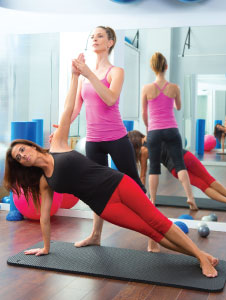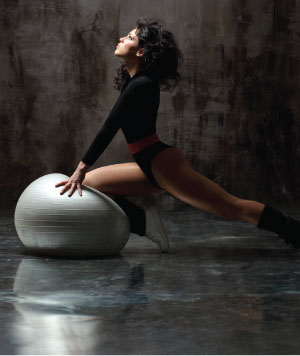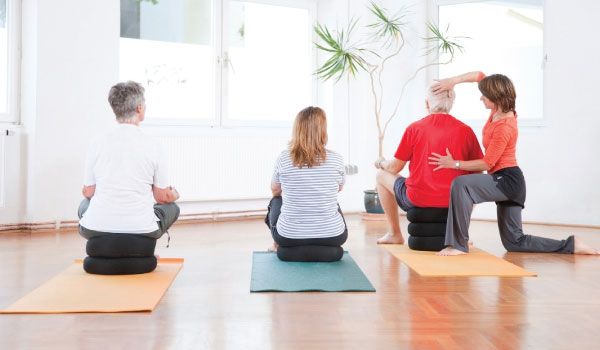Women all around the world are giving up or pushing aside conventional exercise practices like weight training, cardiovascular exercises and even yoga for this relatively new trend called Pilates.
 Pilates (pronounced pill-ah-tees), also known as contrology, is a form of exercise developed by Joseph Pilates in the early 1900s. It emphasises the balanced development of the body through core strength, flexibility and awareness in order to support efficient, graceful movement.
Pilates (pronounced pill-ah-tees), also known as contrology, is a form of exercise developed by Joseph Pilates in the early 1900s. It emphasises the balanced development of the body through core strength, flexibility and awareness in order to support efficient, graceful movement.
Though initially developed for rehabilitation of war soldiers and for treatment of injuries, Pilates soon drew the attention of dancers and elite athletes. It was later in the 1980s, when the exercise science caught up with the Pilates principles, that people all around the world began dedicating themselves to this form of body sculpting principally to build core strength and flexibility. It is also as a mean of rehabilitation for aches and pains of various kinds.
Centring, control, flow, breath, precision and concentration are the six essential principles of Pilates. In his book, Return to Life through Pilates, Joseph Pilates stated, “Self confidence, poise, [and] consciousness of possessing the power to accomplish our desires with renewed lively interest in life are the natural results of the practice of Contrology [Pilates].”
A closer look
To learn more, I talked to Jane D Barrica, a physical therapy and Pilates specialist who is currently an instructor at La Fontaine Centre for Contemporary Art.
“Coming from a background of physical therapy, I have always wanted to incorporate treatments and healing into workout routines. That’s when I heard about Pilates and underwent training in Hong Kong,” Jane says.
“Many people think that Pilates is only for the injured or for rehabilitation. The truth is anyone can practise it. In my five years of teaching, many women have achieved great goals in body sculpting and relaxing
the mind.”
Pilates requires intense concentration and focus, which is great for relieving stress. It is centred on strengthening the inner core, deep stretching and focused breathing. It offers a wide range of benefits, including developing self awareness, proper alignment and positioning of the body, and building symmetry and co-ordination. It develops the inner core, which in turn leads to an improved body tone and stronger muscles.
Pilates vs yoga
Worldwide, Pilates has proven to relieve all kinds of back-related aches and pains, build a strong, supple back, good posture and an efficient movement pattern. The key focus points are the abdominal muscles, lower back and the buttocks.
It incorporates extensive work using machines as well as mat exercises. The founder of the exercise routine stated in his book that Pilates connects the body and mind, but does not unify the two as yoga does.
“Pilates builds abdominal strength and symmetrical musculature along with flexibility, precision and coordination of movement with adequate breaths. On the other hand, yoga focuses on exercise in the form of various poses and centres on breathing techniques along with concentration,” Jane explains.
A success story
 Women often tend to postpone workout sessions. Finding motivation and avoiding boredom is hard, especially when it comes to keeping up with exercise regimens. But this isn’t the case with Pilates, according to Fatima Ali Reza, a successful entrepreneur.
Women often tend to postpone workout sessions. Finding motivation and avoiding boredom is hard, especially when it comes to keeping up with exercise regimens. But this isn’t the case with Pilates, according to Fatima Ali Reza, a successful entrepreneur.
“It’s key to have a good instructor, who can help keep you stay concentrated and focused on the routine. Pilates works from the inside out, mostly due to the varying movements incorporated with breathing,” Fatima says.
“It was during my trip to Paris in the year 2000 that I first heard of Pilates and ever since I’ve been hooked on to it. The benefits are many. Just one hour of the routine makes me feel like I’ve done three hours of yoga. I feel my body is much firmer than it used to be. It has also improved my posture,” she adds.
Women need to educate themselves about this form of body sculpting. Contrary to the popular saying ‘no pain; no gain’, Pilates isn’t painful. It is just a matter of devotion and concentration along with regular practice. Positive benefits can be seen within weeks.
Give it a try
Pilates has gained accolades from women all around the world for being a successful method that actually works with regards to weight loss, which is just one of the benefits of regular practice.
Experts guarantee that this exercise improves toning of muscles, postural stability, core strength and peripheral mobility. It enhances functional fitness, ease of movement and body awareness. It is easy on the joints as it is low impact. Above all, it can be customised for different people, including those with injuries.
Pilates is known to be the best form of exercise to prevent lower back pain and functional disability linked to the spine and posture. Studies show that nine out of 10 rehab specialists prefer it as the best exercise for back and postural rehabilitation.
Body and mind
It is essential to get trained under a professional instructor as many people have different reasons to begin practice and different requirements according to their body and current state of health. Pilates benefits the injured and non-injured equally.





































